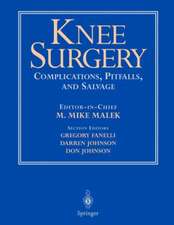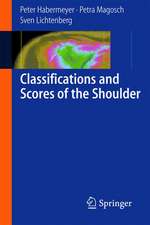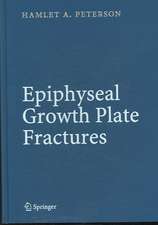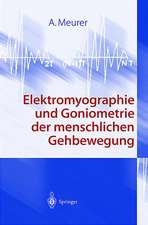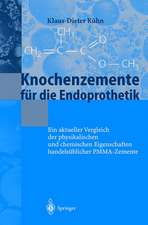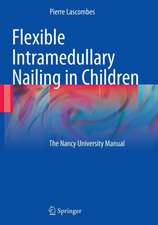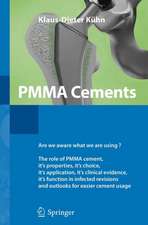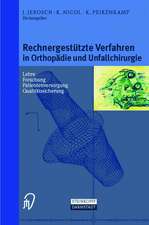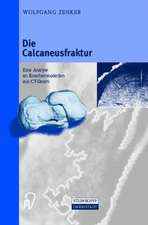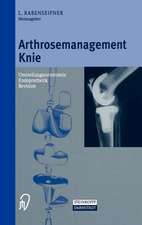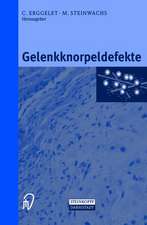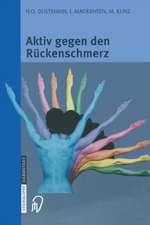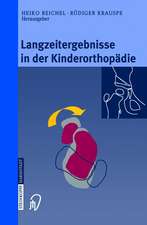Management of Periprosthetic Joint Infection : A global perspective on diagnosis, treatment options, prevention strategies and their economic impact
Editat de Klaus-Dieter Kühnen Limba Engleză Hardback – 3 noi 2017
On the basis of their personal experience, specialists from all over the world present, explain and discuss preventive approaches, appropriate diagnostic strategies for detection, reproducible effective surgical treatments as well as the economic impact of PJI. The reader can use this book as a solid platform for comparing their own approach to PJI treatment with the specialists’ recommendations.
Preț: 1050.87 lei
Preț vechi: 1106.18 lei
-5% Nou
Puncte Express: 1576
Preț estimativ în valută:
201.11€ • 209.19$ • 166.03£
201.11€ • 209.19$ • 166.03£
Carte disponibilă
Livrare economică 24 martie-07 aprilie
Preluare comenzi: 021 569.72.76
Specificații
ISBN-13: 9783662544686
ISBN-10: 3662544687
Pagini: 366
Ilustrații: XVIII, 366 p. 196 illus. in color.
Dimensiuni: 170 x 244 mm
Greutate: 0.91 kg
Ediția:1st ed. 2018
Editura: Springer Berlin, Heidelberg
Colecția Springer
Locul publicării:Berlin, Heidelberg, Germany
ISBN-10: 3662544687
Pagini: 366
Ilustrații: XVIII, 366 p. 196 illus. in color.
Dimensiuni: 170 x 244 mm
Greutate: 0.91 kg
Ediția:1st ed. 2018
Editura: Springer Berlin, Heidelberg
Colecția Springer
Locul publicării:Berlin, Heidelberg, Germany
Cuprins
1.Introduction.- Interview – Gehrke and Parvizi (D/USA).- 2. Economic.- Economic aspects of periprosthetic joint infections – Hanstein and Skripitz (D).- Periprosthetic Joint Infections in the spectrum of the German Diagnosis-Related Groups (G-DRG) System – Gravius and Kohlhof (D).- 3. Clinical Aspects.- Clinical Aspects of Prosthetic Joint Infection – Moretti and Parvizi (USA).- 4. Diagnosis.- Diagnosis of prosthetic joint infections – Drago and De Vecchi (I).- Diagnosis of pathogens – Wagenaar et al. (NL/D).- Diagnosis of pathogens causing periprosthetic joint infections – Segreti (USA).- 5. Prevention.- Prophylaxis for implant-related infections: current state of the art – Boot and Vogely (NL).- Prophylaxis during total hip and knee replacement – Chan and Partington (UK).- Strategies for Preventing Infections in Total Hip & Total Knee Arthroplasty – Jones et al. (AUS).- Treatment and prevention of bone and joint infection: clinical practice in the Centre de Référence des Infections Ostéo-Articulaires Complexes (CRIOAc) Lyon, France – Viste et al. (F).- 6. Treatment.- Treatment of PJI: Overview – Kabata and Tsuchiya (JP).- Treatment of orthopedic septic revisions in the Medical University of Graz – Amerstorfer and Glehr (A).- Treatment of prosthetic joint infections – Hendriks et al. (NL).- The University Hospitals of Louvain experience and care pathways for PJI’s: how we do it – Neyt (B).- Treatment of prosthetic joint infections – Borens and McManus (CH).- Prosthetic joint infection: Treatment – Berstock and Webb (UK).- Dutch protocol for treatment of PJIs with illustrative clinical cases – Ten Broeke (NL).- 7. ALBC.- Benefit and risks of antibiotic-loaded bone cements – Sanz-Ruiz et al. (E/D).- Therapy using antibiotic loaded Polymethylmethacrylate (PMMA) – von Foerster et al. (D).- The roles of antibiotic loaded bone cement (ALBC) in periprosthetic joint infection – Chang (TAI).- Revision Bone Cements in Surgery of Periprosthetic Joint Infections (PJI) – Malhotra et al. (D).- 8. Spacer.- Spacer management – Villanueva-Martinez et al. (E/D).- Articulating cement spaces for the treatment of hip and knee arthroplasty associated infections – Campbell (AUS).- Spacer management in the treatment of late periprosthetic infections of the hip – Fink (D).- Spacer management – Singisetti and Stockley (UK).- 9. Coating.- Antibacterial coating of implants in orthopedics and trauma: finding the right pathway to a more effective surgical site infection prevention – Romanò et al. (I).- Anti-infective coating to prevent prosthetic joint infection (PJI) – Kabata and Tsuchiya (JP).- Aspects of antimicrobial implant coating – Kolb et al. (D)
Notă biografică
Univ. Prof. Dr. Klaus-Dieter Kühn, Senior Scientific Advisor, Heraeus Medical GmbH, Wehrheim im Taunus
Textul de pe ultima copertă
Periprosthetic joint infection (PJI) is among the most serious complications in the field of endoprosthetics. The number of PJIs is increasing worldwide and poses a real interdisciplinary challenge for everyone involved. For the patient concerned, it is necessary to promptly work out an adequate therapy solution to fight off the infection. Both the clinical experience of the surgeon and the proper diagnostic processes are prerequisite for the reliable detection and identification of an infection. The microbiologist is responsible for identifying the causative germs by screening the patient’s synovial fluid and tissue samples. Based on the findings and subsequent resistance testing, the infectious disease specialist can recommend the appropriate antibiotic therapy. Furthermore, the clinical pharmacist is consulted regularly throughout the therapy to discuss the risk of potential drug interactions. The surgeon will proceed with the revision surgery, following defined algorithms. Adequate radical debridement of infected and necrotic surrounding tissue is the most important step towards a successful cure of the infection. Accompanying the surgery, anti-infective agents are given systemically and locally. While systemic application of anti-infectives mainly reduces the number of haematogenic-spreading planktonic germs, local application immediately forms a colonization barrier and protects the implant from sessile biofilm formation. Concurrently, antibiotics are actively released from the implant, resulting in local germ reduction. Thus, local agents are embedded in the concept of surgical PJI treatment as a reliable adjuvant measure and they sustainably support the successful outcome. In one-stage procedures, local agents are released from specialized antibiotic-loaded bone cements, while in two- or multi-stage procedures, local agents are released from corresponding temporary spacers (interim prostheses). Even from an economic standpoint, the combination of systemic and local agent application is meaningful. Furthermore, there are some interesting trends towards the coating of metallic implants to protect against biofilm formation on the implant surface.
On the basis of their personal experience, specialists from all over the world present, explain and discuss preventive approaches, appropriate diagnostic strategies for detection, reproducible effective surgical treatments as well as the economic impact of PJI. The reader can use this book as a solid platform for comparing their own approach to PJI treatment with the specialists’ recommendations.
On the basis of their personal experience, specialists from all over the world present, explain and discuss preventive approaches, appropriate diagnostic strategies for detection, reproducible effective surgical treatments as well as the economic impact of PJI. The reader can use this book as a solid platform for comparing their own approach to PJI treatment with the specialists’ recommendations.
Caracteristici
Written from Experts
With several coloured figures
Includes supplementary material: sn.pub/extras
With several coloured figures
Includes supplementary material: sn.pub/extras

